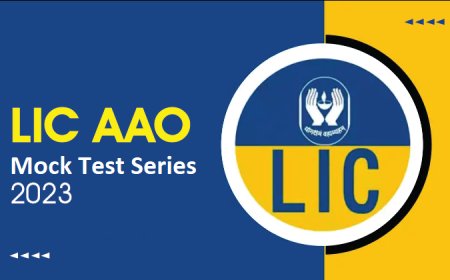AAO Exam - CT 2: Reasoning (Syllogism)
AAO Exam - CT 2: Reasoning (Syllogism)

DIRECTIONS: In the question below are given two statements followed by two conclusions. You have to take the given statements to be true even if they seem to be at variance with commonly known facts. Read all the conclusions and the decide which of the given conclusions logically follows from the given statements disregarding the commonly known facts.
Statements:
Only leaves are feathers.
Only a few leaves are fruits.
Conclusions:
I. Some feathers are fruits.
II. All fruit is feather.
-
Only conclusion I follows
-
Only conclusion II follows
-
Both conclusion I and II follows
-
Either conclusion I or II follows
DIRECTIONS: In the question below are given two statements followed by two conclusions. You have to take the given statements to be true even if they seem to be at variance with commonly known facts. Read all the conclusions and then decide which of the given conclusions logically follows from the given statements disregarding the commonly known facts.
Statements:
No giraffe is donkey.
some donkey are dogs.
Conclusions :
I. No giraffe is dog.
II. Some dogs are giraffe.
-
Only conclusion I follows
-
Only conclusion II follows
-
Both conclusion I and II follows
DIRECTIONS: In the question below are given two statements followed by two conclusions. You have to take the given statements to be true even if they seem to be at variance with commonly known facts. Read all the conclusions and then decide which of the given conclusions logically follows from the given statements disregarding the commonly known facts.
Statements:
No giraffe is donkey.
some donkey are dogs.
Conclusions :
I. No giraffe is dog.
II. Some dogs are giraffe.
-
Only conclusion I follows
-
Only conclusion II follows
-
Both conclusion I and II follows
-
Neither Conclusion I nor II follows
DIRECTIONS: In the question below are given two statements followed by two conclusions. You have to take the given statements to be true even if they seem to be at variance with commonly known facts. Read all the conclusions and the decide which of the given conclusions logically follows from the given statements disregarding the commonly known facts.
Statements :
No cycle is bus.
All buses are trains.
Conclusions :
I. No cycle is train.
II. At least some trains are buses.
-
Only conclusion I follows
-
Either conclusion I or II follow
-
Neither conclusion I nor II follows
-
Both conclusion I and II follow
Statement-I: Only a few Bat are Ball.
Statement II: Only a few Ball are Black.
Statement-III: Few Bat are Card.
Conclusion-I: Some Card are Black.
Conclusion-II: Some Bat are not Black.
-
Only I follows
-
Only II follows
-
Either I or II follows
-
Both I and II follow
DIRECTIONS: In the question below are given three statements followed by two conclusions. You have to take the given statements to be true even if they seem to be at variance with commonly known facts. Read all the conclusions and then decide which of the given conclusions logically follows from the given statements disregarding the commonly known facts.
Statements :
Only a few flutes are drums.
All drums are pianos.
Only a few pianos are Melody.
Conclusions:
I. Some drums are melody.
II. No drums are melody.
-
Only conclusion I follows
-
Only conclusion II follows
-
Neither conclusion I nor II follows
-
Both conclusion I and II follows
Directions: In the question below are given three statements followed by three conclusions. You have to take the given statements to be true even if they seem to be at variance with commonly known facts. Read all the conclusions and then decide which of the given conclusions logically follows from the given statements disregarding commonly known facts.
Statements:
Some Keys are not Locks.
Only a few Locks are Gates.
Only a few Gates are Rooms.
Conclusions:
I. All Lock are Keys.
II. Some Rooms being Keys is a possibility.
III. Some Gates being Keys is a possibility.
-
Only Conclusion I follows
-
Both Conclusion I and II follows
-
Both Conclusion I and III follows
-
All Conclusion follows
Direction: In the question below are given three statements followed by three conclusions I, II and III. You have to take the given statements to be true even if they seem to be at variance from commonly known facts, Read all the given conclusions and then decide which of the following conclusions logically follows from the given statements disregarding commonly known facts.
Statements:
Some Volcano are Magma.
Only a few Magma are Danger.
Some Danger are not Risky.
Conclusions:
I. Some Magma can be Risky.
II. All Volcano being Risky is a possibility.
III. No Magma is Danger.
-
Only Conclusion I follows
-
Only Conclusion II follows
-
Both Conclusion I and III follows.
-
Both Conclusion II and III follows.
Direction: In the question below are given three statements followed by three conclusions I, II and III. You have to take the given statements to be true even if they seem to be at variance from commonly known facts, Read all the given conclusions and then decide which of the following conclusions logically follows from the given statements disregarding commonly known facts.
Statements:
Some Colors are Bright.
All Bright are Colorful.
Some Colorful are not Sketches.
Conclusions:
I. Some Colorful are not Colors.
II. All Sketches being Bright is a possibility.
III. Some Colors being Sketches is a possibility
-
Only Conclusion I follows
-
Only Conclusion II follows
-
Both Conclusion I and III follows
-
None follows
Direction: In the question below are given three statements followed by three conclusions I, II and III. You have to take the given statements to be true even if they seem to be at variance from commonly known facts, Read all the given conclusions and then decide which of the following conclusions logically follows from the given statements disregarding commonly known facts.
Statement:
All Girls are Beautiful.
Some Beautiful are Pretty.
No Pretty is Bad.
Conclusions:
I. Some Girls are Pretty.
II. Some Beautiful are not Bad.
III. All Bad being Pretty is a possibility.
-
Only Conclusion I follows
-
Only Conclusion III follows
-
Both Conclusion I and III follows
-
Both Conclusion I and II follows
Direction: In the question below are given two statements followed by two conclusions numbered I, and II. You have to take the given statements to be true even if they seem to be at variance with commonly known facts. Read all the conclusions and then decide which of the given conclusions logically follows from the given statements disregarding commonly known facts.
Statements
Some bowls are spoons
No spoons are glass
Conclusions
I. Some bowls can never be glass
II. All bowls are glass
-
Only conclusion II follows
-
Both conclusion I and II follows
-
Either conclusion I or II follows
-
Neither conclusion I nor II follows




